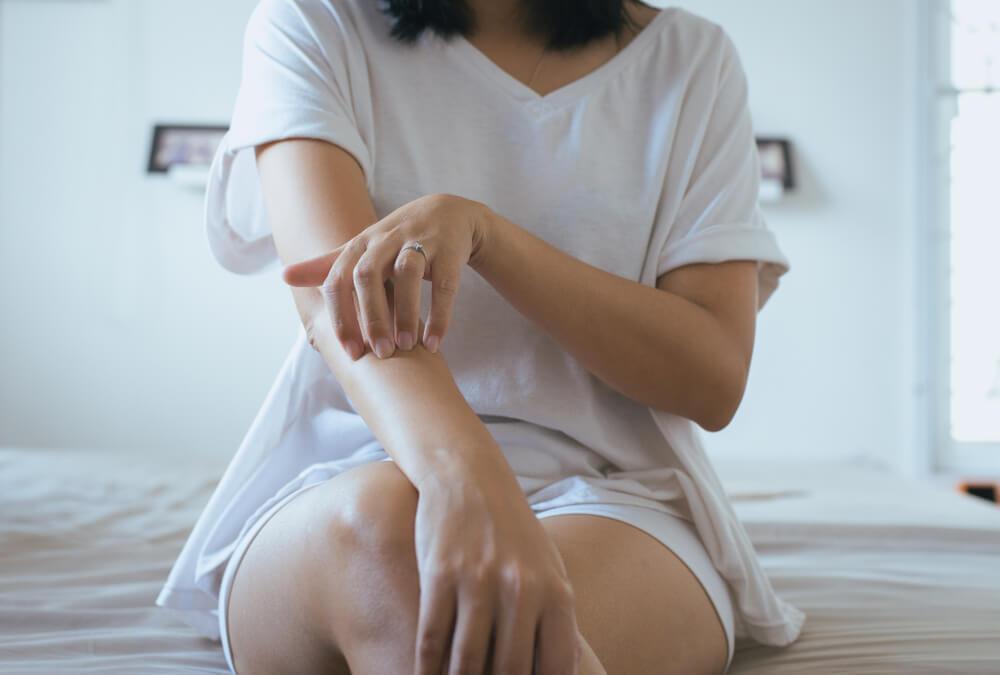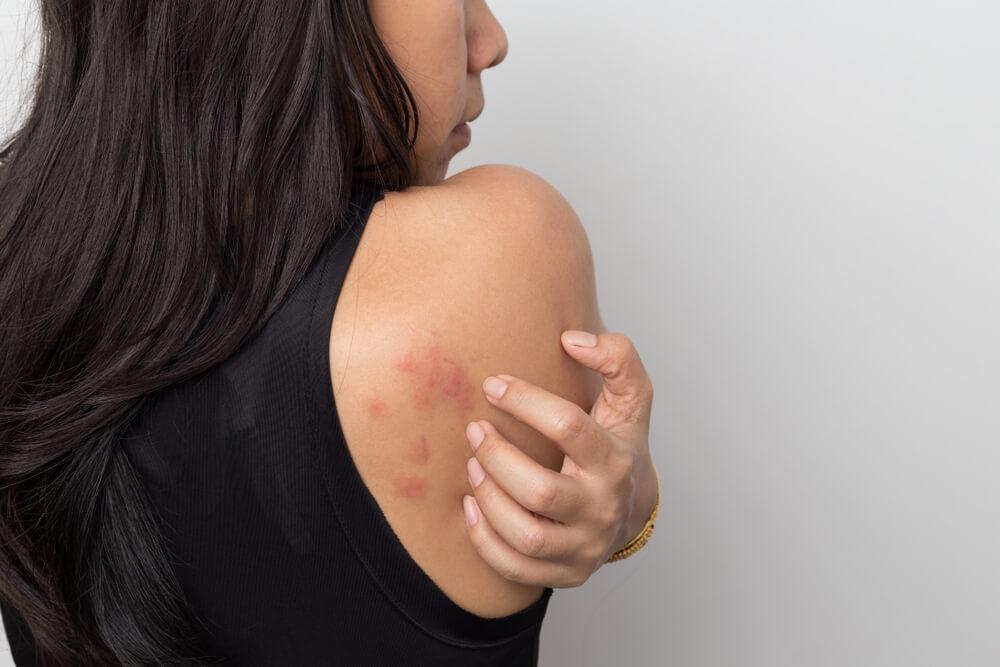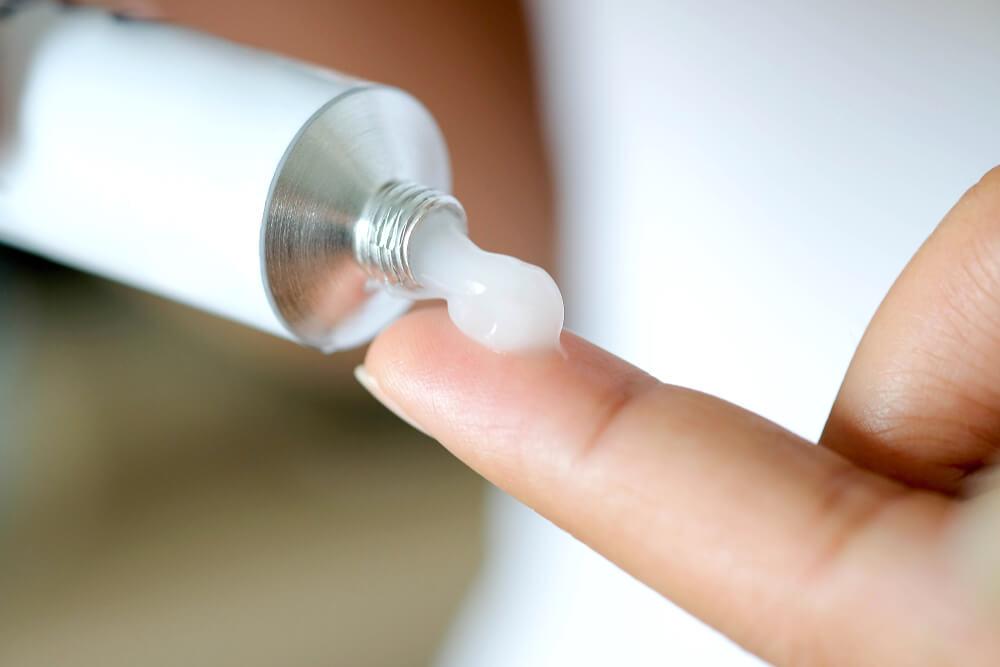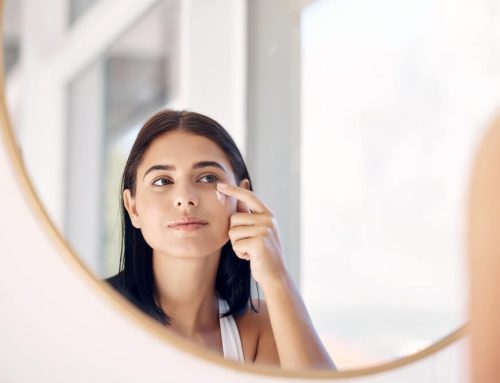It can be easy to get wrapped up in the go-go-go culture, social media, and late-night screen times in the modern world. More than ever, as we battle to adjust our lives around global pandemics and cultural changes, many of us experience excessive amounts of stress.
Stress impacts so many parts of our lives: physically, emotionally, and mentally. Since it is difficult to measure our feelings, it can be hard to justify and link some of these more difficult emotions to their physical consequences.
Everyone experiences stress, some more than others. Believe it or not, it can end up manifesting with physical symptoms. One of these is a stress rash.
What are Stress Rashes?

Stress rashes are a skin flare-up often resulting in hives. They itch and appear like small mosquito bites. Slightly raised from the skin and swollen, as they worsen, they begin to form patches red, pink, perhaps ringed with purple in coloration. When you are trying to obtain a healthy skincare routine, it can be incredibly frustrating.
Rashes caused by stress can end up in hives. If you have preexisting conditions, like psoriasis, rosacea, or eczema, the outbreak might exacerbate these. It can also look very similar to one of these skin conditions, so make sure that your symptoms line up, or get checked out by a doctor before starting any treatments.
Stress rashes show up in all sorts of different ways. The way they do for you could depend on your skin, allergies, triggers, previous conditions, and products. Rashes often show up in the same places repeatedly if caused by similar triggers or situations.
They are common in areas where your body is consistently moist or where you feel pressure from a bra or a waistband.
Stress rashes, or hives caused by stress, are much more common than most people think. Everyone experiences stress, and many of these experience some kind of physical display.
Women are more likely than men to get stress rashes. They don’t always occur from a younger age. They might show up well into their 30s or even start in the 50s.
How to Identify a Stress Rash

Stress rashes, or hives, often look like small, inflamed, red bumps clustered together in patches. They can appear anywhere, although there are likely spots for them to show up, as stated earlier. The areas can be as fine as the tip of the pencil or as large as a plate. They can become apparent in more than one area on the body at a time as well.
Is there a difference between stress hives and a stress rash? Dermatologists don’t tend to use the term “rash” to describe a diagnosis. They will tend to use “hives.” However, they are interchangeable, and one is simply used more by the public than those in the medical field.
Be aware that hives can disappear within 24 hours, or stay for six weeks or longer. It would be considered an acute case if this occurs and is not as common. Those cases that last longer than six weeks are then regarded as chronic rashes.
If your hives do fade within a day, but you continue to experience the same triggers, new ones may form even as the old fade out.
It is essential to understand that a stress rash isn’t only caused by feeling intense amounts of stress for long periods. It can also be caused by other “stressors” to your body. For example, if you are allergic to something, it puts a stress on your body’s systems and can result in a rash.
To figure out if you suffer from a stress rash, try to chart how you feel with what you are experiencing.
Do you consistently experience a stress rash around certain situations such as public speaking events? Do you come into contact with the same thing before your rash appears, like a lotion? Have you introduced anything new to your diet?
Causes of Stress Rashes
The emotion of stress is considered an environmental trigger. There are also viral, illness-related, and allergen triggers that cause stress hives. Common food allergens include:
- Nuts
- Eggs
- Dairy products
- Soy
- Wheat
- Seafood
- Pet dander
- Medications
- Pollen
Other than stress, several environmental factors lead to stress hives. If your skin is exposed to extreme temperatures, then you may suffer from a stress rash. Sunlight, contaminated water, and sweat from exercise are all common triggers.
When you feel stressed, or your body experiences a stress trigger, it reacts hormonally brought on by neurons in your brain. They believe that you are experiencing some form of an attack and set out to protect you. However, it doesn’t always do the trick and can instead cause further irritation or damage.
The neurotransmitters and neuropeptides are extra chemical responses. They change the way your body responds to typical factors. In the end, it can become a clearly physical response resulting in inflammation of the skin, or even just some invisible sensitivity in some areas.
When it relates directly to stress, the cortisol levels your body produces are mostly to blame. These increased levels ramp up your body’s oil production. It is common for this to result in acne breakouts and even loss of hair. It revs up the body’s level of histamine response as well.
The body often responds to higher levels of these uncomfortable histamines via hives or a flareup of your pre-existing skin condition. The good news is that even though scientists don’t have a clear idea of why this trigger occurs, they have figured out how to fix it.
How to Treat Stress Rashes

First, try to wait it out for a day since many times, they will fade out within 24 hours. If you start feeling stressed again, you might want to be on the lookout for the same symptoms.
If it lasts for more than a 24-hour period, you might want to look into various over-the-counter medications to help eliminate these irritating symptoms.
Look into products with antihistamine capacities like Zyrtec or Benadryl since it is often an overflow of histamines that is a reaction to the stress. If you want to calm down the itching, buy cortisone cream.
Other than medication, you can relieve some of the stressors that might be augmenting the situation. For example, try not to wear tight-fitting clothes in areas where the stress rash typically shows up. Keep yourself dry by avoiding strenuous exercise for a while or staying out of the heat.
Both heat and pressure are major aggravators to a condition like a stress rash and will only work together to make it worse.
The time may come when seeing a dermatologist shapes up to be the best choice. If you notice that the medication you try doesn’t help, then look into doctors in your area. You might be someone who needs stronger prescriptions to fully compensate for the histamine production, causing the rashes.
Another great way to prevent a stress rash is to work at limiting the stressful factors. If you have an allergy, now is the time to work with a doctor to identify it. If you experience a lot of stress in your life, reducing it can do wonders for your mental health and your skin.
Alternative Causes of Hives
Unfortunately, there is quite an array of conditions that can cause someone to break out into hives that are not stress-related. These make rash outbreaks harder to identify without careful monitoring of symptoms that you could be experiencing at the same time.
Some of the other rash-related potentials are:
- Eczema – A skin condition that is often chronic and can occur at any age. It often results in layers of dry, flaky skin that span out to form dense red patches. These are made up of small bumps, and the areas are called plaques. It can occur in almost any area of the body.
- Heat rash – Our skin is not made to withstand extended amounts of exposure to intense UV radiation. Staying out in the sun for too long, mainly if your skin is not acclimated to this, can result in a heat rash to develop across the exposed skin.
- Pityriasis rosea – This common skin condition exhibits symptoms often involving patches of small bumps or rashes centered around one more significant rash.
- Contact dermatitis – As the beginning of the name would suggest, this illness happens when you touch or come into contact with an allergen or something abrasive against your skin. It could be a piece of jewelry with an offending kind of metal or some soap or lotion.
- Rosacea – Rosacea is a common skin condition. The rashes are caused by it, and they often appear on your face. It is considered a chronic disease and does not have a cure for it currently.
How to Prevent Stress Rash

Preventing stress rashes is not always possible since they can be caused by developing an allergy to something different. However, if it is stress that would cause it, prevention is critical. Reducing the amount of stress in your life makes all the difference to your health.
We understand that certain aspects that cause stress in your life can’t be avoided. Working in a stressful job or with difficult people is often well out of our control. If you have a hard relationship in your life, you might not be able to get rid of it.
Whether or not these are true for you, there are things you can do to try and limit how stressed out you become over them.
Try exercising regularly, for example. Exercising for at least 20 minutes each day boosts hormonal levels of endorphins. Endorphins or commonly called the “happy hormones” since they are linked to so many positive feelings.
The result is an emotion of satisfaction, increased self-confidence, and calm as you go through the rest of your day.
Many people are surprised by how influential their diet is to how they feel. Food is your only source of nutrients and provides your body with everything it needs to keep on keeping on.
If you do not give it proper nutrition, your systems are incapable of functioning properly. You feel more tired, cranky, and drained by the end of each day, even if you are getting enough sleep.
Speaking of sleep, it is another influential factor that you can do something about. Getting the things done that you need to in enough time to relax and rest aids in reducing stress. If you are too tired to manage your time properly, it impacts your efficiency.
On a physical level, your body heals and regenerates while you sleep. Not getting enough doesn’t allow it to fully “reboot” and can cause a major imbalance in your hormones after a while.
The last one is relaxation. It isn’t always enough for us to get enough exercise, eat, and then sleep, especially if we feel that is all we have time to do. Make yourself a priority and do activities that you enjoy. They might involve exercise, like hiking, or mindfulness, and rest, like meditation.
From cooking to collecting, to working on your car, it is essential to give yourself enough time to process and rejuvenate.
Other Physical Symptoms of Stress
Once you start to suffer from a rash, look for other symptoms. Combining them with certain conditions can help you link it to stress or any other issues that could be going along with it. Since stress involves such a major flux in your hormones, it is often accompanied by other hormone-related issues.
- Hormonal acne
- Decreased energy
- Headaches
- Disturbed sleep patterns
- Muscle tension
- Lowered immunity to colds and infections
There are many more than this as well. Stress can impact every part of your life, and the physical fallout can be disastrous for some.
If you start to notice physical signs of stress, it should be a notice for you to try and reduce stress in your daily life. Symptoms like stress rash can hint at the possibility of worsening conditions in the future.






Leave A Comment